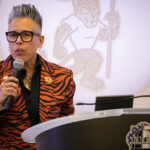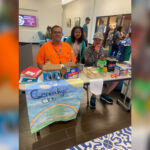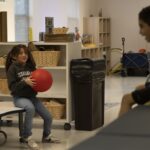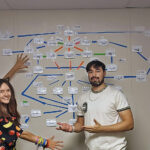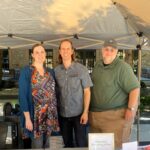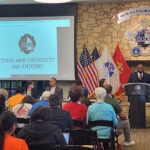
Biology junior Jesus Hernandez places a drop of immersion oil on a laboratory slide before looking through the microscope. He’s looking for trichomonas vaginalis, a human parasite, during a Biology 4430 Parasitology lab at Texas A&M-San Antonio Main Campus Building.
“Remember to ask yourself, ‘What is it?’ and ‘What does it cause?’ And take good notes,” biology Professor Megan Wise de Valdez, said instructing students during the lab exercise and using a teaching microscope that projects the image from the slide to the large screen at the front of the class.
Biology seniors Natalie Forde and Michele Walsh take turns looking through each other’s microscopes trying to identify other human parasites like leishmania donovani, trypanosoma rhodesiense and trypanosoma cruzi.
“I feel like I’m at a real university,” Forde said comparing the new classroom to the classrooms at Gillette. “Even the teachers seem like they’re more in their element.”
The biology department received a total of $64,000 to purchase science equipment for their labs. Items purchased for the biology department include a science-grade refrigerator, two computerized teaching microscopes, 24 compound microscopes, 24 dissecting microscopes and specialized science lab kits. Of the total amount, $51,000 came from a surplus in the construction budget saved by completing the building under budget, and $13,000 came from student fees, collected over the past few years.
The new biology lab buzzes with activity as students retrieve different slides from the instructor’s desk, return to their microscopes, place the slide carefully on the stage and carefully adjust the magnification. One slight over adjustment will knock the contents of the slide from view.
For biology senior Jena Olvera, it’s a welcome change from another university where she attended. “Here, it’s so much better. You don’t have to scream to get the professor’s attention,”
Olvera said.

“It feels good to finally be able to sit in a lab and hold science classes the way they’re supposed to be held,” Wise de Valdez said later in an interview.
“We’re growing like crazy. I think with the new lab, hopefully, people are gonna say ‘We actually have a lab now; maybe I’ll enroll in more classes,’ ” Wise de Valdez said.
The biology department offers 11 courses, including two sections of evolutionary theory and two sections of biology seminar, Wise de Valdez said. She added that she expects to offer 15 courses in the spring along with the theory and seminar courses.
Three new courses to be offered for the spring are molecular biology, immunology and biochemistry, Wise de Valdez said.
One course, field biology, includes taking the students off campus and working outdoors. Friday, the class will be observing birds at Mitchell Lake Audubon Center.
Students can receive a Bachelor of Arts in biology and a Bachelor of Science in biology. Also, the biology department offers a Bachelor of Science in biology with teacher certification.
The department has two full-time professors, three adjuncts and recently hired a lab manager. There are 119 biology majors registered at the university this fall compared to 93 last spring, a growth of 28 percent, Wise de Valdez said.
Dr. William Bush, interim head of the School of Arts and Sciences, said, “It appears to be one of the fastest growing departments in Arts and Science.” He added that the criminology department’s growth is about the same pace.
Bush attributes the department’s growth to the university’s investment in the department as well as faculty efforts.
“I would also attribute it to our faculty reaching out to the community, creating connections with the community colleges, the community and the private sector,” Bush said.
One such connection includes a $7,000 grant from the Texas Engineering Experiment Station and Verano Land Group to study the ambient light and wind patterns in the area surrounding the university.
While small, the grant is a step in the direction to bigger projects, Bush said.
Two biology students under the supervision of the biology faculty have been conducting the study which is expected to completed shortly, Bush said.

